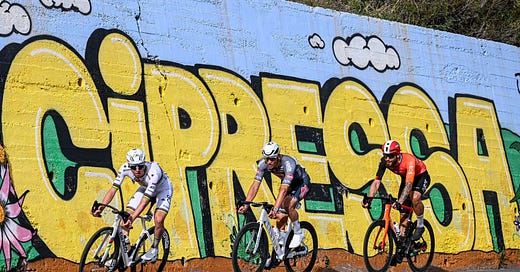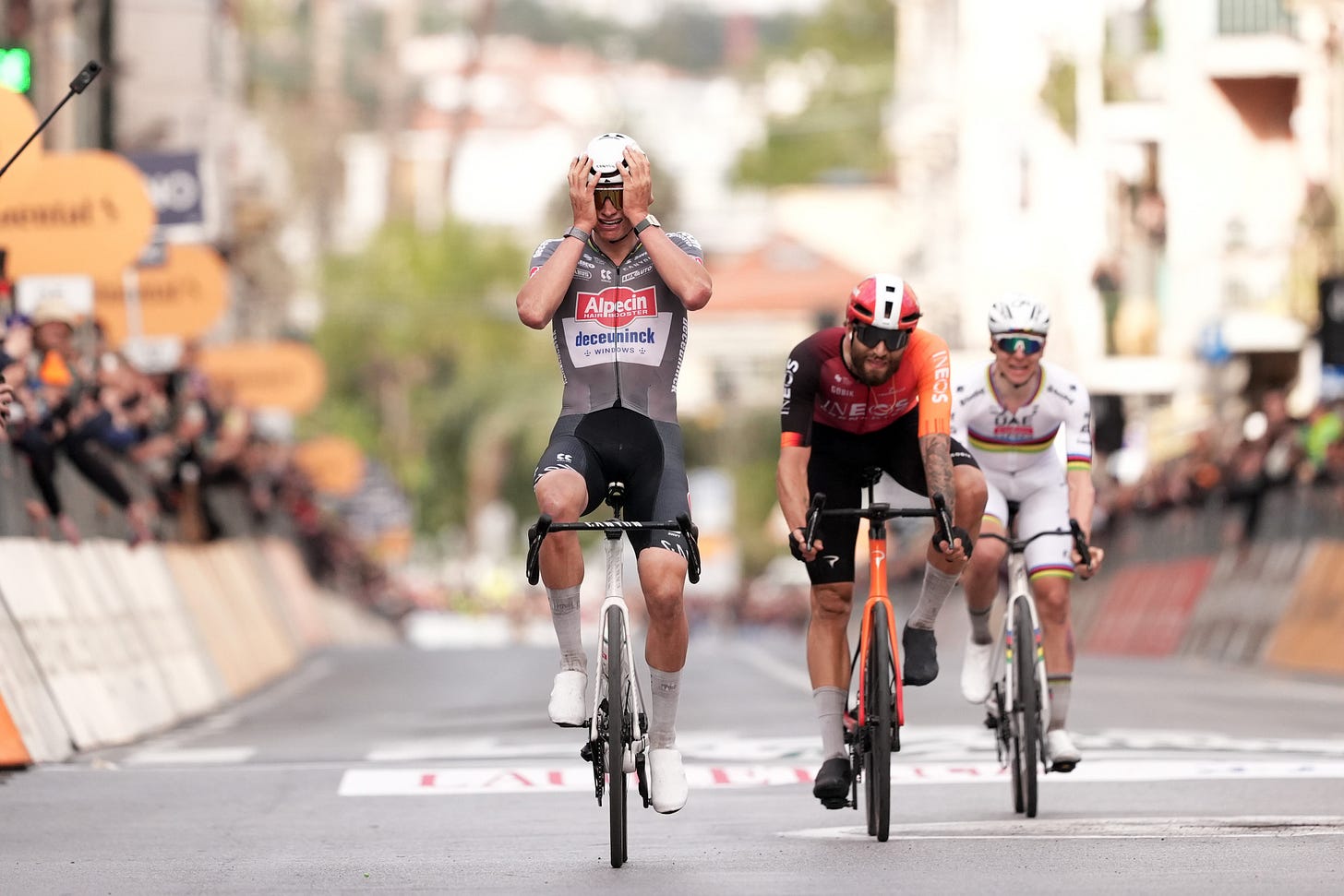The laws of physics gift us a Monumental day
MVDP takes the best Sanremo we can remember. The duel between Pogačar and Van der Poel, Filippo Ganna's appearance, and the attack on the Cipressa define a fantastic race.
Sometimes, clichés pile up when talking about Milano-Sanremo, and I myself fell into several before the race: “Sanremo is the easiest to race, but the hardest to win”, “the best 40 minutes of cycling of the year”. And you know what’s worse? They are absolutely true.
It is also the most unpredictable race of the year, as proven by the fact that we had 17 different winners in the last 17 years until Saturday. And then there’s the Pogačar factor, which changes the rules of every race he enters. This one was no exception.
Mathieu Van der Poel claimed victory at Milano-Sanremo, repeating his 2023 triumph, something no one had done since Óscar Freire. And he did so despite everything unfolding as some people expected, just as Claudio Chiapucci had warned me beforehand: Pogačar’s ferocious attack on Cipressa, followed by a second move from the bottom of the Poggio.
Neither strategy was enough to drop a legendary rider like Van der Poel, who now claims his seventh Monument, matching Pogačar, Boonen, Cancellara, and Bartali. Wow.
"The laws of physics are at play here, I can't do magic", said Pogačar in his post-race interview. The truth is that, while the laws of physics are evident on two ramps like Cipressa and Poggio, the alchemist of our era still tried to defy them. Newton would be proud of Tadej, as he once again proved to be the gravitational force around which everything revolves in modern cycling.
And in the end, his defeat is a guarantee of thrilling racing for years to come.
A true legend
Much has been said about Van der Poel. About his character, his tactics, his reckless decisions in Kuurne, Harrogate, Castelfidardo. But this is a different rider. Van der Poel no longer attacks "because he's cold"; he is now an analytical cyclist, carefully measuring his efforts and selecting his targets with surgical precision. 2023 was the perfect example: Milano-Sanremo, Paris-Roubaix, the World Championship, and runner-up in Flanders against Pogačar.
Virtually everything a rider like him could hope to win.
In the growing rivalry between Pogačar and Van der Poel, the Dutchman’s superior sprint and raw power in explosive situations often give him an advantage over Pogačar. It’s a duel that elevates their victories over one another and will be crucial when assessing their careers in the future.
Cycling isn’t just about how much you win or what you win, but also how you win and, above all, against whom.
This Sanremo may not be his greatest victory, but to me, it is one of his masterpieces.
Calculating
Van der Poel made excellent decisions on Saturday in Sanremo.
With Philipsen struggling after his crash in Nokere Koerse and Pogačar’s inevitable attack before the final stretch of the Poggio, the option of playing a second card was significantly reduced.
At that moment, Van der Poel kept a cool head, allowing Filippo Ganna to take on the chase after Pogačar’s first attack, the most explosive one, despite not coming on the steepest slopes of the race. It was his first key decision on a climb where staying on the wheel is crucial, saving valuable watts.
Later, while cooperating with Pogačar to keep Ganna away, he took on much less responsibility than the Slovenian, responding to every move until reaching the decisive moment: the counterattack at the top of the Poggio, the same place where he won Sanremo two years ago. Despite MVDP's clear advantage in the sprint, I see this as a challenge to TP: he was just as strong, if not stronger. That he wasn’t afraid, and that Sanremo belonged to him. It was his way of delivering a psychological blow.
Van der Poel’s final strategic decision was to anticipate the sprint.
Instead of launching at 200 metres, he went at 300, and he did so just as Pogačar had gained a few metres to start his sprint early, aiming to surprise Van der Poel and Ganna. This move not only showcases his improvement in long sprints but also proves that he is one of the sharpest race readers in the peloton.
Who would have said that four or five years ago?
Alpecin, by the way, secured its third consecutive Sanremo victory, something no team had achieved since Molteni with Eddy Merckx in the early 1970s.
And this time they did it without Philipsen at full strength, but with Kaden Groves, who finished fifth and proved that his Opening Weekend performance was no coincidence. His Tour de France debut isn’t just well deserved, it’s fully justified.
Alpecin controlled the chase throughout the day, with a fantastic effort from Silvan Dillier, showing once again that they are a well-oiled machine in the classics.
The Plan
Pogačar stated after the race that things had gone as planned. And while that was true in broad terms, the early Cipressa section was once again chaotic for UAE, just as their own inside footage revealed.
Isaac del Toro was supposed to be a key man alongside Wellens, setting a brutal pace to ensure Narváez could launch Pogačar at the right moment. However, despite showing strong form throughout the day (finishing 13th), del Toro was nowhere to be seen in the crucial Cipressa phase. UAE ended up poorly positioned, forcing Wellens and Narváez to fight their way back through the group and burn more energy than planned before the decisive moment.
It’s also remarkable that neither Laengen nor Novak made it beyond Capo Berta on a day when UAE never really took control of the race. This is an area for improvement for the strongest team in the world, and perhaps riders like Mikel Bjerg or even Adam Yates could be interesting options for future editions.
Pogačar once again launched too many attacks, as many as six, instead of focusing on one or two decisive moves. It speaks to his impulsive nature, although given the situation, he may not have had any other option once he found himself alongside Van der Poel and Ganna heading into the Poggio.
However, he should reflect on his sprint tactics. He left too much space before kicking from 300 metres out, allowing his rivals to gain an advantage that proved impossible to overcome, once again forcing him into an avoidable extra effort.
The Future
Cycling tends to be a sport of overreactions.
I’ve seen many people saying Pogačar will never win Milano-Sanremo. I have no idea what the future holds, but I wouldn’t write off his chances just yet.
Realistically, this was the closest he’s ever been to winning. I simply believe that one year, the 5 or 6 meters of gap he creates will be 15, and for someone like Pogačar, an outstanding rouleur, that might be just enough.
What I do conclude is that UAE struggled once again with positioning, despite setting the Cipressa record. They could also explore alternative strategies, like picking up the pace from Turchino, attacking on Capo Berta, or playing with a second card, even if it's just to force the others to react, whether that’s Isaac del Toro or Jonathan Narváez.
There’s one potential game-changer on the horizon: Remco Evenepoel. Alongside Pogačar, Van der Poel and Ganna, he is also a rider who can push over 35 km/h on climbs like Poggio or Cipressa.
Given his aggressive racing style, his lack of top sprint speed, and the fact that he’s not the best descender, he could become a crucial ally for Pogačar. If he ever decides to race Milano-Sanremo, his presence could bring a new dynamic, allowing Pogačar to play off attacks and counterattacks instead of carrying the full weight of the race.
That being said, Pogačar's case is nothing like Peter Sagan’s. He’s four years younger than Van der Poel and rides for a team with almost unlimited resources. So, it’s far too early to rule him out. He has a Sanremo win in his legs, and you can bet he’ll keep fighting for it until the very last race of his career.
The History
Cycling fans have been living in a state of constant exaggeration for a while now. Every week feels like we’re witnessing history, and although if something is historic every week it ceases to be so by definition, the truth is that what we are seeing in this era is far from normal. Attacks from 100 km out in World Championships, the break in Sanremo happening on Cipressa… almost nothing we’ve seen since the pandemic follows the usual script.
This historic Sanremo is special, not just because of the riders represented in the top five, which shows how the race has evolved, but also because of the greatness of the contenders themselves.
Van der Poel is strengthening his claim as the greatest pure classics rider in history. After dominating Alaphilippe, Sagan and especially his generational rival Van Aert, he now goes head-to-head with Pogačar, who represents the other side of the coin. Pogačar, in this personal space race, is aiming for the moon, chasing the legacies of Merckx and Hinault, despite how difficult it is to compare eras and riders from different generations.
But don’t worry, this thriller gives us another chapter this Friday in Harelbeke, a mini version of the Tour of Flanders, where Pogačar, Van der Poel and Van Aert will meet again, recreating the 2023 unforgettable battle.
It’s a great time to be a cycling fan, where every race becomes a chance to defy the laws of physics.
Thanks for reading once again. Remember, you can follow Cycling Report on Twitter, Instagram, or Bluesky, as well as on my personal account.
The best way to support the project is to share the content if you enjoyed it!







